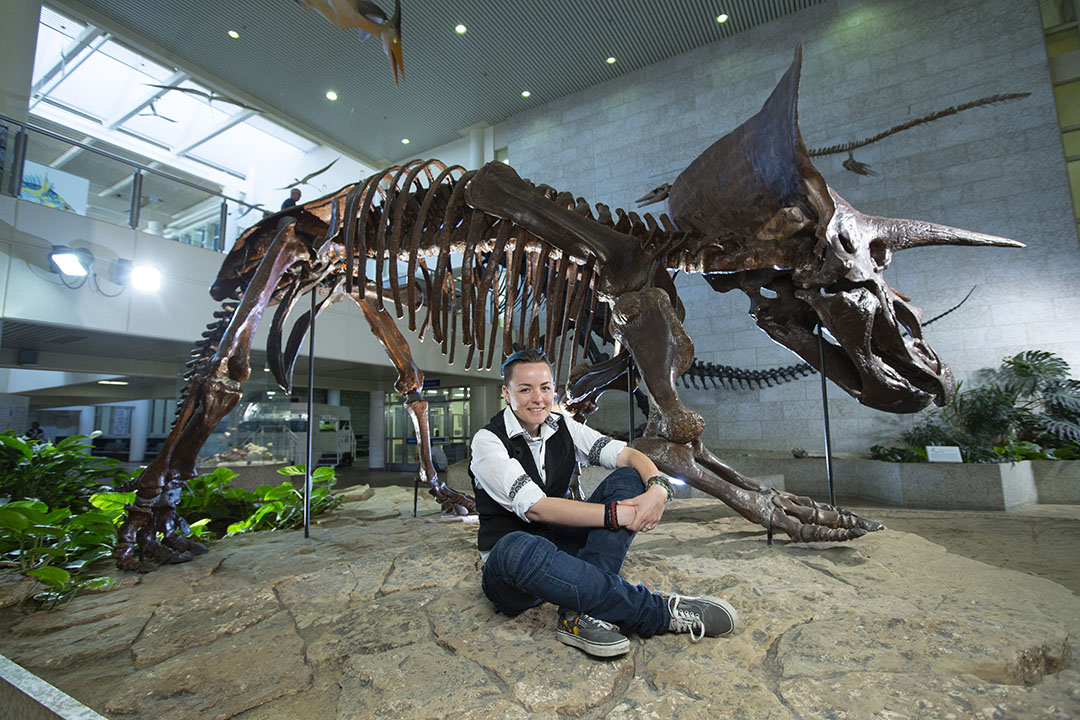
Rocks tell story of Saskatchewan’s tropical past
Swamps, hot weather and flourishing tropical plants. An ocean nearby…. Florida, maybe? No, it’s the story of a long lost Saskatchewan past that Meagan Gilbert is digging up from multimillion-year-old mud and fossils.
By Federica Giannelli“If we understand how animals and plants of the past responded to major environmental changes, we can better prepare for how climate change may affect us in the future,” said Gilbert, a University of Saskatchewan PhD geology student.
Saskatchewan and Alberta were once on the coast of a huge seaway that periodically submerged the land, forcing animals and plants into sudden adaptations.
In one site near the U.S. border, Gilbert found many rare fossil fragments of Ankylosaurus. When alive, the creatures were six-metre-long “dino-lizards” with spiky armour plates on their backs, and tails with a big club-like protrusion on the end.
“My findings definitely put Saskatchewan on the map for studying dinosaurs in Canada,” she said.
Gilbert has found that it is possible to grasp the evolution of climate and life on Earth by tracking sea-level changes. These are indicated by patterns from the deposition of rocks and distribution of fossils in bedrock — the solid rock layer beneath soft soil or rock fragments.
The bedrock patterns indicate the persistence of a hot climate for millions of years in Saskatchewan. Gilbert’s results are published in the journal Palaeogeography, Palaeoclimatology and Palaeoecology.
“Meagan integrated multiple data sets that can result in a deeper understanding of the geological and paleontological past of Saskatchewan,” said U of S geology professor Luis Buatois, one of Gilbert’s supervisors.
With funding from the federal agency NSERC, this is the first study that uses fossils to investigate the interaction between land-based organisms and environment in Saskatchewan’s Cretaceous period, between 75 million and 76 million years ago.
“We see these changes in the fossils we found in the sediment,” said Gilbert. “Animals such as sharks and plesiosaurs that lived in the oceans replaced dinosaurs, mammals, reptiles and amphibians who lived along the shore.”
The next step is to understand the landscape evolution by studying the rocks and badlands where Gilbert found the fossils. Then, she will compare the results with sites in Alberta and the United States to identify whether and why there are regional differences. The findings could help shed light on how climate change works on a global scale.
Over two years, she has dug several sites in southwestern Saskatchewan, including near Lake Diefenbaker, and gathered and identified almost 3,000 plant and animal fossils that are now housed at the Royal Saskatchewan Museum.
“My research requires a tremendous amount of knowledge of both modern and extinct animals,” said Gilbert, believed to be one of the few researchers in Canada whose approach combines geology with fossil science. “You need to identify whether what you are seeing is bone, and what animal it belongs to.”
Last year a girl was in the news for unearthing many fossils at Lake Diefenbaker, and Gilbert helped identify them. During camping season, Gilbert thinks people may turn to the thrill of fossil hunting again.
“It’s great that people love fossils, but anything they find is property of the Crown, so they should report it to the Royal Saskatchewan Museum,” said Gilbert.
Federica Giannelli is a graduate student intern in the University of Saskatchewan research profile and impact unit. This content runs through a partnership with The StarPhoenix.
This article first ran as part of the 2018 Young Innovators series, an initiative of the U of S Research Profile and Impact office in partnership with the Saskatoon StarPhoenix.

